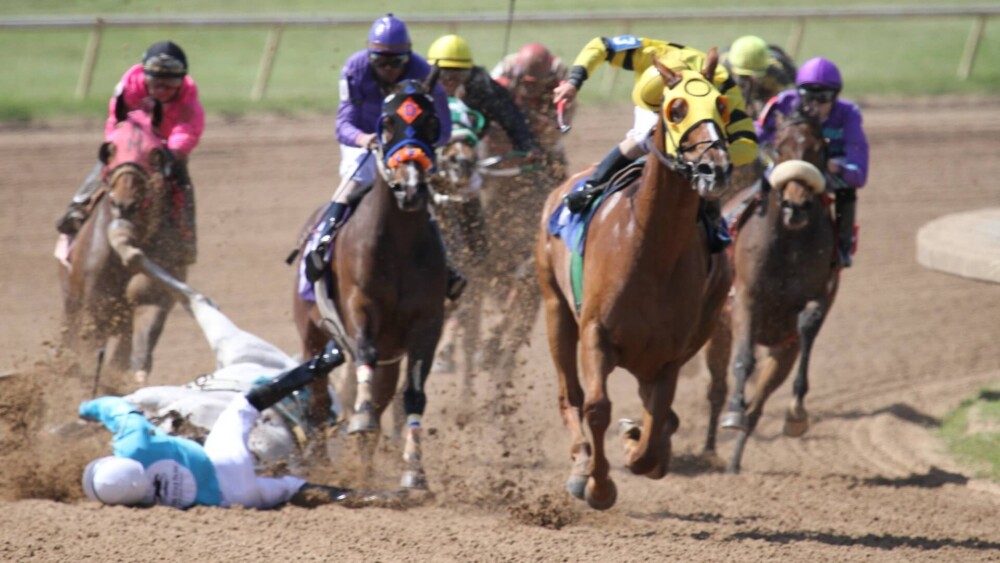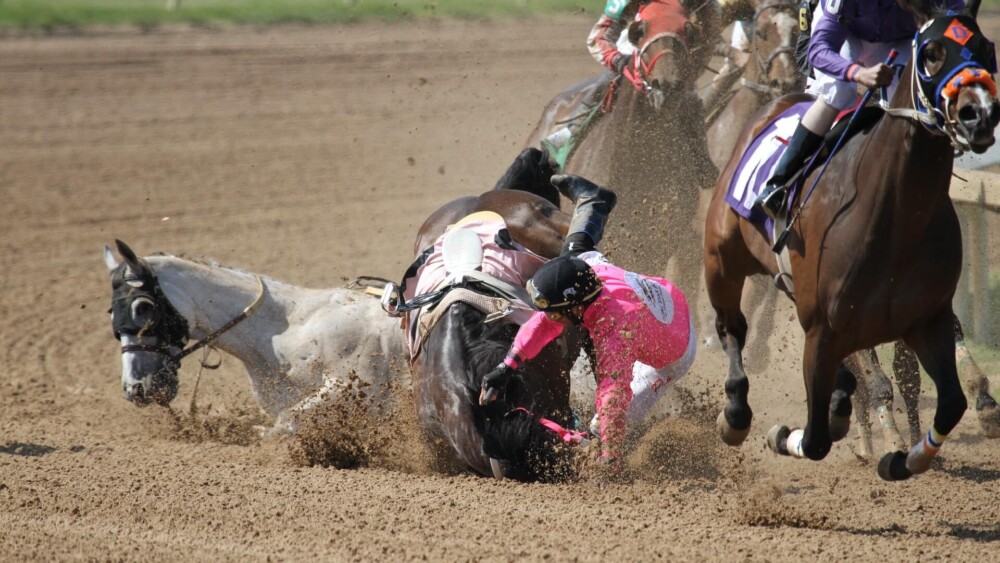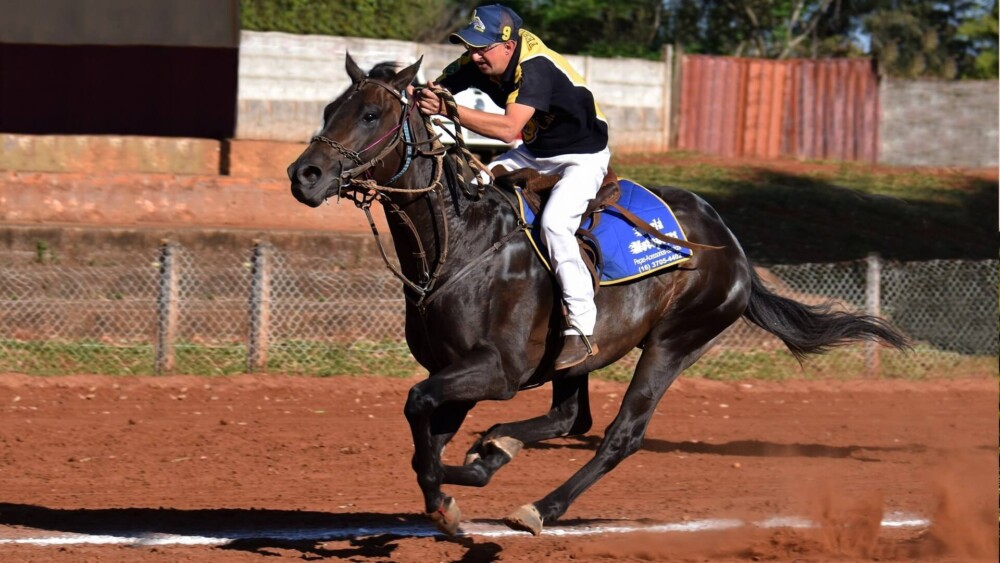For humans, a broken leg is a painful yet treatable condition. For horses, however, the outlook is far less optimistic.
Why is a broken leg often a death sentence for a horse? Horses have very little soft tissue in their legs. When a bone breaks, it can tear the skin or cut off the circulation to the rest of the limb, increasing the chances of infection.
Horses are heavy animals. The hooves are designed to support that weight. But, if one leg is broken the pressure placed on the remaining three is so extreme, it can cause damage to the laminae resulting in laminitis and other complications.
Different Types of Fractures
Some fractures in a horse’s leg are easier to treat than others. A stress fracture, for example, is much easier to treat than a spiral fracture. That’s because a stress fracture involves a partial break rather than a complete severing of the bone.
Stress fractures usually heal quite quickly with rest and rehabilitation, and many horses return to work within a few months.
At the other end of the scale, a spiral fracture often requires intensive surgery, expensive veterinary care, and months of rehabilitation.
There are seven different types of fracture:
1. Simple and Complete Fractures
When a bone in the horse’s leg is broken in a single place, this is called a simple fracture. Treatment will depend on which bone has been broken and where the break has occurred.
2. Comminuted Fractures
A comminuted fracture has multiple breaks. Pieces of bone may become separated. A comminuted fracture of the long pastern bone or phalanx, similar to a human shin bone, can sometimes be successfully repaired. The prognosis is, however, dependent on the severity and complexity of the fracture.
A horse with a comminuted fracture has a fair chance of full recovery, assuming the bone can be accurately reconstructed.
3. Incomplete Fractures
Incomplete fractures are amongst the most common fractures in horses. Also known as stress, “green stick,” or micro-fractures, they are cracks in the bone rather than complete fractures.
Incomplete fractures are difficult to diagnose, and horses suffering from such an injury may only exhibit mild lameness. Untreated stress fractures can easily develop into more serious breaks so, the quicker the fracture is treated, the better the prognosis.
4. Chip Fractures
While chip fractures are a type of incomplete fracture, they deserve a separate identification. The chips of separated bone can be surgically removed, after which there is a high expectation that the horse will return to full athletic soundness.
5. Nondisplaced Fractures
A non-displaced fracture is one in which the parts of the bone have remained in their normal positions. Depending on the location of the fracture and which bone is affected, such fractures are usually relatively easy to repair.
An external skeletal fixation device, such as a splint or cast, is used to stabilize the bone and facilitate healing, especially in the lower limbs. A non-displaced fracture in an upper limb is more commonly treated with internal pins and screws together with a fiberglass cast.
6. Displaced Fractures
When the parts of a fractured bone shift out of their regular positions, it’s a displaced fracture. These are amongst the most difficult to treat. While minimally displaced fractures may heal well with rest alone, more complex displaced fractures in which parts of the bone have moved out of place may require extensive surgery and, in some instances, may be untreatable.
7. Open Fractures
Open fractures where the bone or part of the bone has erupted through the skin are among the easiest to diagnose but are some of the most dangerous as the open wound is prone to infection.
Some Horses Can Make a Complete Recovery After Breaking a Leg
Traditionally, a broken leg would be a death sentence for any horse.
But, new techniques and advances in veterinary science offer horse owners some degree of hope. The cost and complexity of the treatment, however, means many horses with fractured legs still have a poor prognosis. Often, euthanasia is the only option.
Whether it’s a top-competition horse or a well-loved pet, the decision to bring your horse’s life to an end is always a difficult one. Let’s look at the alternatives available and the likelihood of recovery.
Recovering From a Broken Bone: A simple fracture of a long bone or upper limb is rarely treatable, while a similar break in a lower limb can often be stabilized with a splint or cast, facilitating a complete recovery.
In 2018, the Brazilian showjumper, Yuri Mansur, and his horse, Vitiki, suffered a horrendous fall during a jump-off at Aachen. Vitiki suffered a complex fracture of the off-fore pastern but, despite an uncertain prognosis, returned to top-level competition the following year.
Not every horse is as lucky as Vitiki. The damage caused to the musculotendinous structures may weaken the leg to such an extent that a full recovery is impossible.
Fractures That Horses Often Recover From Include:
- A fractured elbow – around 90% of horses survive this type of fracture with many returning to full athletic function after rehabilitation.
- Chip fractures – once the bone chip has been removed arthroscopically, most horses make a full recovery.
- Fractures that have been repaired with screws often heal effectively, becoming even stronger than they were before the injury.
Fractures With a Poor Prognosis Include:
- A displaced fracture of the radius – the bone that extends down from the ulna or elbow – is very difficult to repair.
- Articular fractures affect the horse’s joints and, while they may be surgically repaired, it’s unlikely the horse will return to full athletic function.
- Open fractures are almost always accompanied by infection, especially if implants are used to stabilize the break.
- Complex fractures that have caused a shattering of the bone are complicated to repair, and horses with breaks of this kind often have to be euthanized as there is little chance of recovery.
When a Horse’s Leg Heals
Many horses do make a full recovery after breaking a leg with some even returning to top-level competition.
An Australian racehorse by the name of Il Divo shattered his leg in April and, some five months later, enjoyed his first cautious trot around the paddock. While his recovery is impressive, he won’t return to the racetrack despite his owner investing. $50,000 into his recovery. Il Divo sustained a spiraling fracture in his off foreleg and required extensive surgery that saw 10 screws inserted into his leg.
Emergency first aid plays an integral part in a horse’s recovery. Moving a horse with a suspected broken leg can cause a lot of damage and anxiety for the animal. An injured horse should be kept still and stable and is immediately given drugs to control the pain and inflammation. This gives them a much greater chance of recovery.
In instances where the bone bends before breaking, the chances of recovery are limited. Similarly, if the fracture causes damage to the blood supply or the surrounding muscles, euthanasia may be the only option.
Physiotherapy and rehabilitation help to maximize the function of the broken leg but don’t guarantee that the horse will regain the same level of agility and mobility as it had before the accident.
A horse that’s kept primarily as a pet or for light, non-competitive work, may well recover to the extent that he is no longer in chronic pain and can lead a relatively normal life. He may not be rideable. But, he could quite easily live out the rest of his natural life happily grazing and simply being a horse.

Available Treatments for Horses with a Broken Leg
There are new methods of stabilizing broken bones and better anesthetics that make surgery safer. Usually, a horse would need to be transferred to an equine hospital or surgical center to receive such treatment.
1. Safe Transportation
To transport a horse with a broken leg safely, the affected limb must be stabilized, and the horse kept calm. Veterinarians will usually administer a non-steroidal anti-inflammatory drug such as phenylbutazone (Bute), taking care not to provide such intense pain relief that the horse tries to put weight on the leg. Walking on a fractured bone will exacerbate the condition.
2. Setting the Bones
In the case of a displaced fracture, the first step is to realign the bones. This requires anesthesia and, in the case of larger bones, special equipment. For example, a universal large fragment distractor is used to realign the bones without stretching the joints around the fracture.
3. Bone Support
Once the bones are back in position, screws, pins, or plates are inserted to support the bone while the fracture heals. In many instances, these will remain in place for the rest of the horse’s life.
An external cast made of fiberglass or synthetic resin is usually sufficient for stabilizing a simple or incomplete fracture. While cheaper than internal supports, these casts must be changed frequently while the horse is under anesthetic, increasing the overall cost of the treatment.
4. Limb Support
Even with a cast, many horses recovering from a broken leg develop laminitis in its healthy limbs. The prolonged weight bearing on the opposite healthy limb disrupts the normal internal function of the hoof, resulting in laminitis. (Check out Degloved Hoof Injuries)
This problem can be resolved with the use of a sling or similar support system.
For years, slings have been used to support injured horses, giving their broken leg a chance to mend by supporting their weight. The use of such slings comes with its own problems, however.
The horse’s heavy weight means that not only is the horse’s normal movement restricted but their weight lies on the thorax and abdomen, causing pressure sores to develop and inhibiting the normal movement of the internal organs.
In some instances, this causes compression of the lungs, leading to even more critical complications.
Euthanizing a Horse With a Broken Leg
There are two ways to euthanize a horse: lethal injection or humane killing with a gun. Lethal injection is the most common method of euthanasia. The horse is given an overdose of an anesthetic drug, administered by intravenous injection. Humane killing involves a gun being placed to the horse’s forehead, resulting in instant death.
With both methods, a sedative is administered first to prevent the horse from becoming distressed.
A horse that is euthanized with a lethal injection will lose consciousness after the injection and slowly collapse. Its heart stops beating shortly after the injection is administered and the horse is already unconscious when its heart stops beating.
Euthanasia by shooting causes the horse to fall down instantly. It will bleed from the nose or head but will be completely unaware of the process.
With both methods, there will be some involuntary movement of the limbs, as well as twitching, and gasping for breath. While the horse is in no discomfort during these movements, it can be distressing for an owner to witness so, you may not want to be present.
While a shot to the head is a less peaceful process than lethal injection, it’s often a more dignified way to end a horse’s life, especially for one that’s needle shy.

The Most Common Causes of Broken Legs in Horses
Broken legs are relatively common among horses, especially racehorses that have been bred to have lighter bones. Around 60% of the horse’s weight rests on its front legs that, while strong, are comparatively fragile compared to the horse’s weight.
Most broken legs occur when excessive force is put on the bone.
Common causes include:
- An awkward misstep;
- A bad fall;
- An awkward kick;
- Undue strain at competitive events.
Conditions and Dietary Issues That Can Cause Brittle Bones
Most horses have strong bones, although they do weaken as the horse ages. Brittle bones can also be the result of a condition known as Equine Bone Fragility Syndrome. Calcium deficiency can also compromise their strength.
Equine Bone Fragility Syndrome
Equine Bone Fragility Syndrome, also known as osteoporosis or silicosis, is a chronic disorder that causes lameness, stiffness, skeletal deformities, and fractures. The cause of the condition is unknown, although it is almost always accompanied by a chronic lung disease known as pulmonary silicosis.
Equine Bone Fragility Syndrome only affects horses that have previously lived or currently reside in California. Also known as silica-associated osteoporosis, it is associated with pulmonary silicosis. This condition is caused by the inhalation of toxic silica crystals. These crystals are found in the soil and, once inhaled, move into the lungs and surrounding lymph nodes, causing chronic inflammation.
Calcium Deficiency
Calcium is an important part of a horse’s diet, especially when they’re still growing. Calcium deficiency can cause a decrease in bone density, leading to a condition known as osteopenia. This condition makes a horse more susceptible to broken bones.
As with humans, bone density in horses also decreases with age. This condition can be managed with a calcium-rich diet coupled with regular exercise and turn-out time, both of which are beneficial to bone density and joint mobility.
Rehabilitating a horse with a broken leg
In adult horses, a broken bone takes at least four months to heal. Once healed, veterinarians may recommend rehabilitation exercises in the form of swimming, water treadmills, and other non-concussive mobilization. Physiotherapy, and other techniques like Masterson’s Method, can also help restore mobility and rebuild damaged muscles.
Conclusion
The chances of a horse making a full recovery after breaking a leg depend on the location and severity of the fracture. Some may recover to full athletic function, while others may make only a partial recovery. In the worst-case scenario, where surgery is unlikely to restore the horse’s mobility and weight-bearing abilities, euthanasia is the only humane option available.
My Favorite Equine Resources For Horses and Donkeys
This list contains affiliate products. Affiliate products do not cost more but helps to support BestFarmAnimals and our goal to provide farm animal owners with accurate and helpful information.
Squeaky Chicken Toy is hilarious to watch and the horses love it! It’s not super tough so keep it away from dogs.
Dewormer with Ivermectin: I use this for my horses and my goats. Duvet makes a great dewormer. I switch between the Ivermectin one and one like this one so the worms don’t get immune to it.
Manna Pro Apple Flavored Nuggets are a delicious smelling treat that my horses go crazy over.
Equinity Amino Acid Supplement for Horses makes a big difference for any horse that’s struggling with arthritis, hoof issues, or just generally. It’s great for older horses who can’t absorb all the nutrients in their food as well!
Manna Pro Weight Accelerator helps older horses gain weight and stay healthier! This was especially helpful when one of my older horses lost weight over the winter and helped her regain her weight over the summer!
Farnam Fly Control goes on the horse or donkey and will keep the flies off your sweet pet. It makes horses way more comfortable and will keep sores from getting infected as well.
Wound Kote protects sores and wounds. It acts as an antiseptic and helps wounds heal faster. It works on both my horses and goats.



